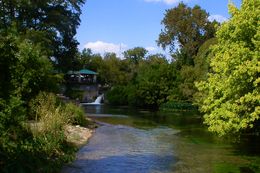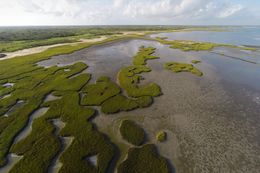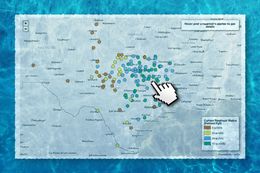|
Welcome
to Trib+Water, a water news wrap-up and analysis prepared every other week by
The Texas Tribune and the Meadows Center for Water and the Environment at
Texas State University. We bring you the latest news and events concerning
the river systems of Texas and important water issues on a state and regional
level.
|
|||||||||||||||||||||||||||||||||||||||||||||
|
Vol:
2 Issue: 25:
|
|||||||||||||||||||||||||||||||||||||||||||||
|
"Watershed News" will have the dual mission of reporting the work of our volunteers and keeping you informed of the issues concerning land and water in the Wimberley Valley. Together, we are all working to protect Jacob's Well and the waters that make this place so beautiful.
Wednesday, December 17, 2014
TRIB+Water Volume: 2 Issue: 25
Friday, December 12, 2014
Why water is not the new oil
Why water is not the new oil
By Sharlene Leurig, Dec. 8, 2014
 |
| Photo by Gabriel Cristóver Pérez |
“Water is the new oil.”
Nowhere is this platitude more recited than here in Texas, where homegrown oil-and-gas money — and now even global capital — is flowing into the next resource boom: groundwater.
T. Boone Pickens’ Mesa Water, which was the first to acquire groundwater rights from landowners for export to thirsty communities, is just the best-known name in the state’s burgeoning groundwater market. It also includes BlueWater Systems, the Val Verde Water Company, Heritage Commodity and Forestar.
In October, Abengoa and BlueWater won approval for a $3.4 billion project to pipe groundwater 140 miles from Burleson and Milam counties to San Antonio.
We Texans are by no means alone in commoditizing water. The share price of Cadiz, the sponsor of a project that aims to mine and bank groundwater beneath the Mojave Desert and sell it to parts of drought-stricken California, has more than doubled in the past year. A new water futures market was launched this year in Australia.
It’s indisputable that there’s money to be made in water, especially as it becomes scarcer. But at what cost? Treating water as a commodity, no different than oil, neglects fundamental differences that we ignore at our peril. Here are three reasons why water is not the new oil:
Yet decisions on whether to deplete or sustain aquifers often hinge on wide-ranging, often outdated, legal frameworks developed over a century ago.
In Montana and Oklahoma, where water above and below ground is the property of the state, pumping is limited to quantities that would not affect surface water flows. In California, new landmark legislation promotes improved groundwater management, but the law still lacks teeth to enforce pumping limits. Here in Texas, where groundwater is private property, courts have found that even reasonable groundwater regulation may be a “taking” of private property. These courts have even gone so far as to suggest that groundwater production be shaped in the image of oil and gas regulations, which are designed to maximize production.
Right now, individuals, local communities, corporations and investors have equal opportunity to destroy long-term economic value by over-pumping our groundwater resources. They’re also vulnerable to the global trend of aquifer depletion, which threatens long-term economic health and national security.
We can create water markets that protect groundwater for the future and meet our needs today, but those markets cannot mirror those of oil. To develop markets that work, we need consistent regulatory frameworks that limit groundwater use. With water use capped and sufficient water maintained for ecological and basic human needs, regulators can rationally structure trading between water users.
Today, these markets are far too rare, especially those that enable trading between hydrologically connected groundwater and surface water users. Given that all Texas rivers begin as groundwater, investing in the union of these legally divided water systems through integrated regulation and market-based water sharing has the potential to create value for all of us — both those of us who are alive today and generations far into the future.
Disclosure: T. Boone Pickens has been a major donor to The Texas Tribune. A complete list of Tribune donors and sponsors can be viewed here.
Nowhere is this platitude more recited than here in Texas, where homegrown oil-and-gas money — and now even global capital — is flowing into the next resource boom: groundwater.
T. Boone Pickens’ Mesa Water, which was the first to acquire groundwater rights from landowners for export to thirsty communities, is just the best-known name in the state’s burgeoning groundwater market. It also includes BlueWater Systems, the Val Verde Water Company, Heritage Commodity and Forestar.
In October, Abengoa and BlueWater won approval for a $3.4 billion project to pipe groundwater 140 miles from Burleson and Milam counties to San Antonio.
We Texans are by no means alone in commoditizing water. The share price of Cadiz, the sponsor of a project that aims to mine and bank groundwater beneath the Mojave Desert and sell it to parts of drought-stricken California, has more than doubled in the past year. A new water futures market was launched this year in Australia.
It’s indisputable that there’s money to be made in water, especially as it becomes scarcer. But at what cost? Treating water as a commodity, no different than oil, neglects fundamental differences that we ignore at our peril. Here are three reasons why water is not the new oil:
- Oil has no value except in its production. Water, in stark contrast, creates value intrinsically. Flowing rivers enhance property values; dried-up riverbeds diminish them. Groundwater plays a critical role in this value creation, as its slow, steady seepage into rivers creates reliable baseflows beyond the uncertain supplies from unreliable rainfall. If that hydrological connection is severed through over-pumping, the value the water once created is lost.
- When an oil reservoir is depleted, the value of the land will decline, but the land itself will still have some use. When economically viable water has been removed from an aquifer, the usefulness of the land above it is irrevocably damaged.
- Oil will eventually be replaced by other forms of energy, but water will always be as necessary to future generations as it is for us today. While it may be economically rational to maximize oil production while it’s still in demand, there are many reasons not to maximize production of groundwater. Water provided freely by nature will always be more cost-effective than water produced through treatment or transported from far away.
Yet decisions on whether to deplete or sustain aquifers often hinge on wide-ranging, often outdated, legal frameworks developed over a century ago.
In Montana and Oklahoma, where water above and below ground is the property of the state, pumping is limited to quantities that would not affect surface water flows. In California, new landmark legislation promotes improved groundwater management, but the law still lacks teeth to enforce pumping limits. Here in Texas, where groundwater is private property, courts have found that even reasonable groundwater regulation may be a “taking” of private property. These courts have even gone so far as to suggest that groundwater production be shaped in the image of oil and gas regulations, which are designed to maximize production.
Right now, individuals, local communities, corporations and investors have equal opportunity to destroy long-term economic value by over-pumping our groundwater resources. They’re also vulnerable to the global trend of aquifer depletion, which threatens long-term economic health and national security.
We can create water markets that protect groundwater for the future and meet our needs today, but those markets cannot mirror those of oil. To develop markets that work, we need consistent regulatory frameworks that limit groundwater use. With water use capped and sufficient water maintained for ecological and basic human needs, regulators can rationally structure trading between water users.
Today, these markets are far too rare, especially those that enable trading between hydrologically connected groundwater and surface water users. Given that all Texas rivers begin as groundwater, investing in the union of these legally divided water systems through integrated regulation and market-based water sharing has the potential to create value for all of us — both those of us who are alive today and generations far into the future.
Disclosure: T. Boone Pickens has been a major donor to The Texas Tribune. A complete list of Tribune donors and sponsors can be viewed here.
TX H2O-Can we start thinking of water as a crop?
 |
|
Workers install a fence on the 77 Ranch as part of
Water As A Crop’s cost-share program to promote
sustainable land management.
Photo by Craig Ficenec, Water As A Crop.
|
Water is not traditionally thought of as a crop, but Water As A Crop® and its partners are hoping to change that. This organization promotes the idea that water falling on private, rural land can be effectively conserved and marketed in a manner similar to crops. In exchange for implementing conservation practices, rural landowners receive financial incentives to reimburse their costs. These conservation practices benefit investors and landowners and preserve water for rural and urban communities alike.
Water As A Crop was founded in 2009 by the Sand County Foundation, a private, nonprofit organization based in Madison, Wisconsin. The organization works nationwide to promote land and water stewardship.
Following the foundation’s mission “to advance the use of ethical and scientifically sound land management practices and partnerships for the benefit of people and the environment,” Water As A Crop bridges gaps between rural and urban, private and federal, and corporate and individual. The program brings together landowners, local partners and stakeholders interested in funding water conservation in water-stressed areas, said Craig Ficenec, Water As A Crop program director.
Water As A Crop connects watershed stakeholders, including corporations and various conservation groups, interested in providing financial incentives to landowners who implement best management practices (BMPs). These incentives are then used to mitigate the costs of implementing conservation practices.
“The concept is to just get urban investors to reinvest in their water supply by targeting land management practices that will enhance that water supply,” said Blake Alldredge, former Texas A&M AgriLife Extension Service associate.
“The premise of Water As A Crop is that much of the land is privately owned, especially in the state of Texas, meaning that the majority of the rainfall falling on the land is on private land,” Ficenec said. Therefore, its quality and quantity is, in part, subject to the management practices of that land.
Water As A Crop bridges gaps between rural and urban, private and federal, and corporate and individual. The program brings together landowners, local partners and stakeholders interested in funding water conservation in water-stressed areas.
However, there are barriers to proper water stewardship. For instance, urban water users often recognize the importance of clean water but may not fully understand private, rural landowners’ critical role in helping produce a clean, plentiful water supply. Some landowners may not be aware of BMPs that help maintain high water quality, or they may not have the financial resources to implement them.
Water As A Crop emphasizes the responsibility and potential impact both urban and rural residents have in water conservation. By implementing strategies that reduce runoff and conserve water, rural landowners provide clean water for urban residents, Ficenec said. In turn, urban residents and corporations should recognize the contributions of private landowners by investing in these conservation strategies.
“The overall idea with Water As A Crop is that if I [a landowner] save the folks in Houston — downstream from the Trinity — money by not having to clean up the water so much, then how can those dollars and those savings find their way back to the landowners in the watershed to do more conservation work and do it faster? That’s the whole concept,” said Gary Price, owner of the 77 Ranch in Navarro County.
Using partnerships to protect Texas water
Although the Sand County Foundation and Water As A Crop have nationwide interests, the struggle for water in Texas drew the program here.“Texas is facing a lot of water issues and is going to need to depend on private lands and how landowners manage their private lands as a major component of how Texas delivers its water needs sustainably into the future,” Ficenec said.
Currently, the state water plan does not include recommendations on land management strategies to improve water conservation. Therefore, Texas is a prime candidate for a program wanting to test conservation and management strategies.
The amount of private land ownership, commercial interest and cooperative landowners are the three elements that led to Water As A Crop’s work in Texas, Ficenec said.
Because commercial water users’ profit margins can be greatly affected by water quality and quantity, there is potential for investments in water stewardship by corporations and other organizations, sources said. Seeing this potential, Water As A Crop partners with companies, such as MillerCoors, which uses water from the Richland-Chambers Reservoir to manufacture and brew beer.
“We started working in Texas and in partnership with MillerCoors, a water user in Fort Worth, who had interest in the watershed, how land is managed in the watershed and how that affects the water quality and quantity in the Richland-Chambers Reservoir, which in turn affects the water supply for its operations,” Ficenec said.
Besides MillerCoors, Water As A Crop has also helped coordinate funding from organizations such as the Dixon Water Foundation, Meadows Foundation and Knobloch Family Foundation to support conservation efforts in the Trinity River basin. A significant amount of funding was also provided by the U.S. Department of Agriculture–Natural Resources Conservation Service (USDA–NRCS) National Water Quality Initiative and Tarrant Regional Water District.
“Texas is facing a lot of water issues and is going to need to depend on private lands and how landowners manage their private lands as a major component of how Texas delivers its water needs sustainably into the future.”Using this funding from collaborators, Sand County Foundation facilitated reimbursement to landowners for the costs of conservation practices such as building fences for rotational grazing and planting riparian buffers, sources said.
The 77 Ranch leads the way
One of the most significant factors in the implementation of Water As A Crop is the cooperation and involvement of local landowners, such as Gary and Sue Price of the 77 Ranch. Water As A Crop officials got to know Gary Price when he was awarded the Leopold Conservation Award from the Sand County Foundation and Texas Parks and Wildlife Department in 2007. |
|
Ranchers Gary and Sue Price, owners of the
77 Ranch, were part of the Water As A
Crop program.
Photo by Blake Alldredge.
|
As a rancher in the Trinity’s Chambers Creek Watershed, Price has implemented conservation strategies that have the potential to conserve water. He plants and manages native grasses to reduce water loss, while simultaneously managing forage for wildlife and livestock. The Prices also provide educational opportunities for rural and urban residents to learn about the importance of private lands in water conservation.
“We must work together to try to bridge some of those rural-urban gaps,” Price said. “One of the things that intrigued us about Water As A Crop is that we both see opportunity when we say that everybody’s drinking water comes across somebody’s ranch somewhere. So, that means that I play a vital role in a pretty big product.”
Because of his interest in private land stewardship and conservation, Price became the “anchor” for Water As A Crop’s work in the Chambers Creek Watershed, according to Ficenec. “He’s very cooperative and very interested in the concept of how private landowners can deliver water conservation and off-farm water benefits while they are also doing well for themselves by good land management.”
“We must work together to try to bridge some of those rural-urban gaps.”The Prices’ collaboration with Water As A Crop has led to continual monitoring and data collection efforts on their land to identify the most effective land stewardship practices for conserving water. This information will be used to help landowners make management decisions and will allow investors to see the success of their investments.
Trinity Waters partnership proves fruitful
Water As A Crop’s collaboration with Gary Price also opened the door to a partnership with Trinity Waters, a Texas-based organization dedicated to the conservation of the Trinity River, which supplies water to more than 40 percent of the Texas population, according to the group.From 2010 to 2012 the two organizations conducted a pilot project in which Trinity Waters served as the local implementing partner within the Trinity River Watershed. The project took place in Mill Creek, a tributary of Chambers Creek that supplies urban residents in Fort Worth and surrounding communities via the Richland-Chambers Reservoir and then joins the Trinity River downstream. There, the organizations collected data and educated local landowners through workshops.
 |
|
Through workshops given on the 77 Ranch,
rancher Gary Price
educates landowners and others on the importance
of land stewardship
and its impacts on both land and water.
Photo by Blake Alldredge |
The work that was initiated in Mill Creek by Water As A Crop and Trinity Waters led to the watershed being selected to participate in the Chambers Creek Water Quality Initiative, the only program in Texas that was part of the USDA-NRCS National Water Quality Initiative, sources said. This allowed federal funds into the area to assist with improving the water quality in Chambers Creek. Around $5 million was contributed to cost-share programs within the Chambers Creek Watershed in 2012 and 2013, Ficenec said.
“The true benefit of the pilot was to show the success and the conservation potential in that market that drew the federal funding attention to it, which was a large portion of the funds for the program,” Cook said.
Current efforts, near and far
In Texas, Water As A Crop is currently focused on monitoring and collecting data to compare the effectiveness of different management strategies in conserving water, Ficenec said. This data will allow the organization to better communicate to landowners and address questions regarding which management practices to implement. “It’s a matter of outreach and cooperation with landowners and trying to demonstrate the potential benefits to them, both in terms of production and profit,” Ficenec said.“We try to partner with researchers at Texas A&M University and others to look at monitoring and modeling techniques that can come closer to answering those questions,” he said. “Because, obviously, if anyone wants to invest in promoting land conservation, which could be through direct financial incentives or outreach and education or whatnot, anyone investing in that wants to know there will be a return.”
Much of the monitoring is currently being done on the 77 Ranch. In particular, the amount of precipitation and discharge is being monitored to estimate how much water infiltrates the soil, said Dr. Bill Fox, Texas A&M AgriLife Research scientist.
“Currently, we are monitoring three small watersheds on Mr. Price’s ranch; they’re of different vegetation communities,” Fox said. Those areas are a tall grass prairie, a mid-grass prairie and a mesquite savannah, and each one reacts differently to water. The data being collected will calibrate the response of these three systems to rainfall and allow future comparisons to be made, he said.
Price has been actively involved in the continued monitoring and allows visitors to the ranch to gain a better understanding of how the monitoring is being done. He stresses the importance of the research, saying that there is nothing like having a landowner look at the monitoring devices and see the data produced, rather than simply reading about it on paper. Providing this information to landowners is key to empowering them in making important management decisions, he said.
“Our monitoring efforts and our research are not focused on trying to develop something to tell somebody to do what they need to do,” he said. “What we try to do is develop information so that people can make informed decisions based on their goals, their land needs, their families, whatever it may be.”
In addition to working along the Trinity River, Water As A Crop has been involved in various efforts around the nation, including a project in the central Big Sioux River of South Dakota, upstream of the iconic Sioux Falls. Reducing bacteria and sediments in the river are a primary concern for citizens and for Water As A Crop, Ficenec said.
“What we try to do is develop information so that people can make informed decisions based on their goals, their land needs, their families, whatever it may be.”In this region, Water As A Crop is focusing on local soil conditions, which affect the amount of sediment runoff into these streams. The organization is encouraging landowners in the area to adopt practices such as adding cover crops or practicing no-till farming, Ficenec said.
Water As A Crop is also working in the Midwest, particularly in Iowa and Nebraska, areas also affected by water quality issues. In Nebraska the program is focusing on groundwater recharge and irrigation efficiency, Ficenec said, whereas in Iowa it is focused on cropping practices associated with nutrient runoff.
The Sand County Foundation plans to continue expanding Water As A Crop, helping landowners throughout the country and collecting data to inform management practices.
“Water As A Crop still envisions, as a long-term objective, that those end users of water, be they industrial or residential, though a water district or so forth, would actually see enough value in the contributions that private lands could make, providing an ecological service of clean and quality water that leaves their lands and to see that as something worth investing in,” Ficenec said.
Subscribe to:
Posts (Atom)












